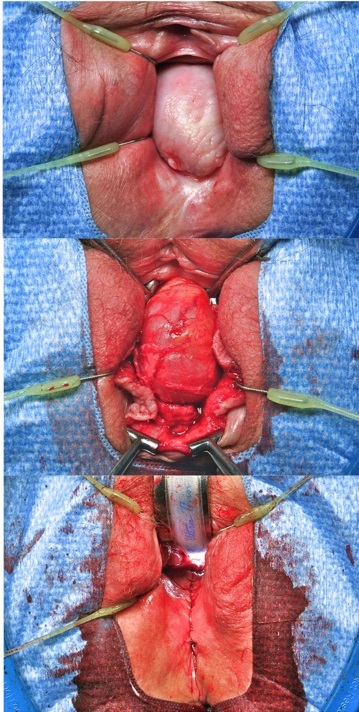Vaginal Vault Prolapse (Fallen Vagina)
After a hysterectomy a vagina that loses its support may come down and out like an inside-out sock. If a woman still has her uterus then this is called a uterovaginal vault prolapse. If only the uterus falls out and the top of the vagina is still well suspended then it is called a uterine prolapse. Vaginal vault suspension can be done in many ways. You can use the patient’s own weakened tissues or augment the repair using a biologic product such as human cadaver skin dermis or polypropylene nylon. Some physicians prefer an abdominal approach to attach the top of the fallen vagina to the sacrum. Some highly skilled surgeons do this laparoscopically with a Sacralcolpopexy. That is when you suture the top of the vagina to a bony prominence of the sacrum deep inside the pelvis.
Robotic surgery has made this easier this past decade and today’s recently trained graduates use this route as their primary approach. The vaginal approach to suspending the top of the vagina used to be the most common but it is becoming less and less as their surgical numbers in training programs decline. The top of the vagina can be sutured to the uterosacral ligaments or to the sacrospinous ligaments through the vaginal approach. Either approach works well with different complications to consider. The vaginal surgery skills needed for this excellent technique is getting lost in today’s academic training programs. You have to find a high-volume surgeon that gets enough of these cases to remain competent. The success rates of all methods are approximately the same at 80 – 90%.

Severe Vaginal Vault Prolapse is like an inside-out sock falling out of the vagina. What is inside is usually small bowel and an enterocele that must be blocked, reduced, closed off. The top of this can then suspended using sutures and ultralightweight mesh. This can also be repaired laparoscopically, with or without robots, and suspended with ultralightweight mesh. These are not easy surgeries and success depends on the surgeon and their skills. It is one of the toughest repairs to do as a urogynecologist.
Here is another example of a patient who had a hysterectomy decades ago and now finding the support of the top of her vagina lost and something pushing out. The bulge of the vagina had an enterocele inside of it as seen in my dissection. Her doctors all thought it was a simple cystocele or fallen bladder but it was really all small bowel. There was a rectocele also, the small bump below the large bump in the middle picture, so I fixed that too.

